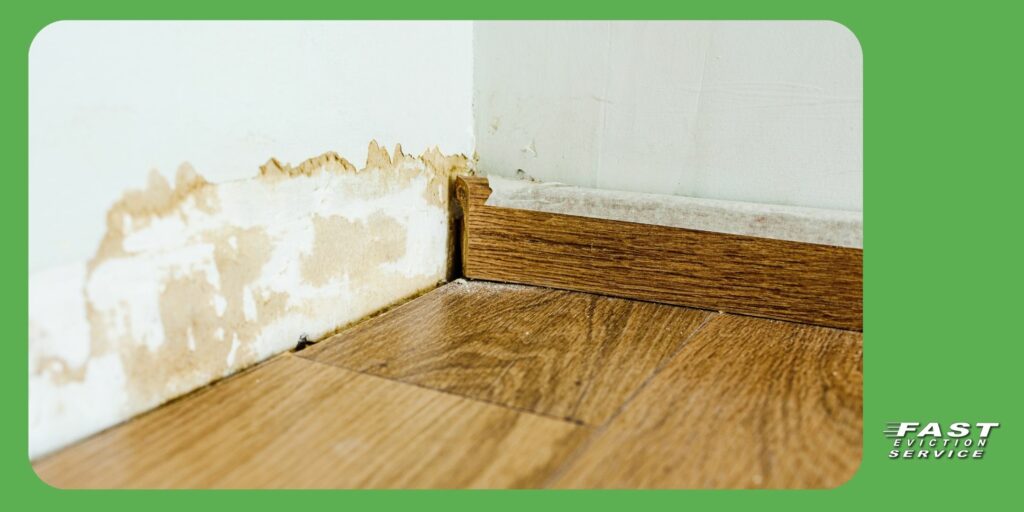You are represented at all times by one of our California Eviction Attorneys | 1-800-686-8686 | intake@fastevict.com | Se habla español
Slumlord Risk in California: A Landlord’s Guide to Habitability, Repairs, and Compliance
In California’s ever-changing rental housing landscape, landlords must do more than simply collect rent: they must maintain safe, habitable, and code-compliant homes. Failing to meet these obligations can quickly lead to tenant complaints, code enforcement actions, and the dreaded “slumlord” label.
Whether you own a single rental or manage multiple units, understanding habitability requirements, proper repair procedures, and new compliance rules like AB 628’s 2026 appliance mandate is essential to protect both your investment and your reputation.
Key Takeaways
- California landlords are legally required to maintain safe and habitable housing under Civil Code §1941.1.
- Proactive maintenance and timely repair responses are the best ways to avoid “slumlord” claims.
- Proper documentation, 24-hour entry notices, and clear communication protect landlords from disputes.
- Retaliation laws prohibit evicting or penalizing tenants for reporting habitability concerns.
- Beginning January 1, 2026, landlords must supply and maintain a working stove and refrigerator (AB 628).

Table of Contents
- Understanding “Slumlord” Risk in California
- The California Habitability Baseline
- Proactive Maintenance and Inspections
- Handling Repair Requests the Right Way
- Lawful Entry and Tenant Communication
- Avoiding Retaliation Claims
- Working with Code Enforcement
- Tenant-Caused Damage vs. Normal Wear
- Preparing for AB 628: California’s 2026 Appliance Rule
- Conclusion: Staying Far from the “Slumlord” Line
Understanding “Slumlord” Risk in California
The term slumlord has become a powerful warning word in California’s rental market. It describes landlords who ignore property maintenance, violate habitability standards, or neglect tenant safety.
But often, landlords don’t intend to be negligent. Misunderstandings, poor record-keeping, or delays in handling repairs can still expose property owners to serious claims. Under California law, failing to maintain basic living standards—even unintentionally—can result in code violations, rent withholding, and costly penalties.
Being proactive about compliance and communication helps you stay far from the “slumlord” line while protecting your rental business.
The California Habitability Baseline
Under Civil Code §1941.1, every rental property must be “fit for human occupation.” Landlords cannot waive this requirement—even with tenant consent. A habitable unit must include:
- Effective weatherproofing and watertight roof/walls
- Plumbing with hot and cold running water
- Functional heating
- Safe electrical wiring and outlets
- Sanitary bathroom and kitchen facilities
- Lockable doors and operable windows
- Free from vermin, mold, and excessive dampness
These minimum standards form the implied warranty of habitability, a non-negotiable obligation that every California landlord must meet.
Starting January 1, 2026, AB 628 expands these requirements to include a working stove and refrigerator unless the tenant provides their own by written agreement.
Proactive Maintenance and Inspections
Routine inspections prevent minor problems from becoming major liabilities. California landlords should follow a seasonal inspection schedule, checking:
- Roofs and gutters for leaks
- Plumbing for corrosion or water intrusion
- Heaters and HVAC systems before winter
- Electrical breakers, outlets, and GFCIs
- Windows, locks, and smoke/CO detectors
Mold and moisture control are among the biggest triggers for habitability claims. Respond to leaks within 48 hours and document all repairs. The same applies to pest control—California requires written bed bug disclosure and education under Civil Code §1954.603.
Proactive landlords who maintain inspection logs and vendor invoices can easily prove due diligence if issues arise later.
Handling Repair Requests the Right Way
Tenant complaints are inevitable, but how you respond determines your legal exposure.
- Centralize Requests – Use email or a property management system to log repair requests and responses.
- Acknowledge Quickly – Confirm receipt in writing and provide an estimated completion date.
- Prioritize Severity – Address safety issues (heat, plumbing, electrical) first, followed by non-urgent repairs.
- Document Everything – Keep before-and-after photos, invoices, and communications.
If a tenant threatens to use “repair and deduct” (under Civil Code §1942), respond promptly and professionally. Tenants may repair essential issues and deduct up to one month’s rent—but only if the landlord ignores written notice. A documented, timely response protects you from this remedy.
Lawful Entry and Tenant Communication
California’s Civil Code §1954 sets strict rules for entering occupied units. Landlords must:
- Provide 24-hour written notice (email, mail, or door posting).
- Enter only for lawful reasons—repairs, inspections, showings, or emergencies.
- Schedule entries during normal business hours.
If a tenant refuses entry, document your attempts and communicate alternatives in writing. Never enter without notice or attempt “self-help” access—it risks retaliation claims or privacy violations. Clear, professional communication is your best defense.
Avoiding Retaliation Claims
California’s Civil Code §1942.5 prohibits landlords from retaliating against tenants who make good-faith complaints about habitability or contact code enforcement.
To stay compliant:
- Maintain neutral, documented reasons for any rent increase or termination.
- Avoid taking negative action for at least six months after a complaint.
- Keep inspection records and maintenance logs to demonstrate good faith.
Retaliation cases can void an eviction or lead to financial penalties. Always handle complaints through documentation and professionalism—not emotion.
Working with Code Enforcement
When a tenant files a complaint, code enforcement officers may inspect the property. This doesn’t automatically mean a violation—it’s an opportunity to show compliance.
- Provide maintenance records, photos, and invoices.
- Allow prompt re-inspection once repairs are complete.
- Respond professionally to correction notices and keep proof of compliance.
Cooperating with inspectors, rather than resisting them, helps demonstrate that you’re a responsible property owner committed to tenant safety.
Tenant-Caused Damage vs. Normal Wear
Not all repair responsibilities fall on landlords. California law distinguishes between normal wear and tear (landlord responsibility) and tenant-caused damage (tenant responsibility).
Examples of tenant-caused conditions include:
- Broken fixtures or unauthorized alterations
- Unreported leaks or pest infestations due to poor sanitation
- Damage from negligence or misuse of appliances
Protect yourself with a move-in checklist and photo documentation. Conduct periodic inspections and have tenants sign acknowledgment forms. If damage occurs, you may deduct costs from the security deposit per Civil Code §1950.5.
Preparing for AB 628: California’s 2026 Appliance Rule
Effective January 1, 2026, Assembly Bill 628 requires most California landlords to supply and maintain a working stove and refrigerator.
Steps for compliance:
- Inventory every rental unit for appliances and condition.
- Update lease language for new and renewal agreements.
- Schedule maintenance checks to ensure functionality.
- Track repairs and replacements for future inspections.
Failing to comply may trigger habitability claims, even if the rest of the unit is in good condition. Start preparing now to stay ahead of enforcement deadlines.
Conclusion: Staying Far from the “Slumlord” Line
The best landlords in California aren’t just compliant—they’re proactive, organized, and transparent. By maintaining properties to habitability standards, responding promptly to repairs, and documenting all communication, you’ll avoid “slumlord” accusations and protect your investments long-term.
In California’s regulated rental environment, documentation and diligence are your strongest shields.



